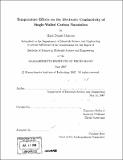| dc.contributor.advisor | Francesco Stellacci. | en_US |
| dc.contributor.author | Mascaro, Mark Daniel | en_US |
| dc.contributor.other | Massachusetts Institute of Technology. Dept. of Materials Science and Engineering. | en_US |
| dc.date.accessioned | 2009-03-16T19:47:14Z | |
| dc.date.available | 2009-03-16T19:47:14Z | |
| dc.date.copyright | 2007 | en_US |
| dc.date.issued | 2007 | en_US |
| dc.identifier.uri | http://hdl.handle.net/1721.1/44817 | |
| dc.description | Thesis (S.B.)--Massachusetts Institute of Technology, Dept. of Materials Science and Engineering, 2007. | en_US |
| dc.description | Includes bibliographical references (p. 57-59). | en_US |
| dc.description.abstract | The room-temperature electronic conductivity and temperature dependence of conductivity were measured for samples of carbon nanotubes of three types: pristine; functionalized with a nitrobenzene covalent functionalization, which are expected to display poor electronic conductivity; and functionalized with a carbene covalent functionalization, which are expected to display pristine-like conductivity. Measurements were taken via four-point probe measurement across palladium contacts on a silicon surface coated with a distribution of nanotubes. Room-temperature measurements indicate that carbene-functionalized tubes do exhibit significantly greater conductivity than nitrobenzene-functionalized tubes, but also significantly less than pristine tubes. Statistically different distributions of resistances observed in similarly prepared samples indicate that this measurement technique is strongly affected by uncontrollable and so far uncharacterizable parameters of the employed sample preparation technique. Measurements at varying temperature indicate the expected linear relationship of resistance and temperature is dominated in pristine and carbene samples by a effect, possibly contamination-related, which significantly and permanently increases the resistance of samples after cycling to high temperatures, and which occurs repeatedly with additional cycling. Carbene-functionalized samples were observed to exhibit similar temperature behavior to pristine samples, while nitrobenzene-functionalized samples displayed erratic, unpredictable behavior. | en_US |
| dc.description.statementofresponsibility | by Mark Daniel Mascaro. | en_US |
| dc.format.extent | 59 p. | en_US |
| dc.language.iso | eng | en_US |
| dc.publisher | Massachusetts Institute of Technology | en_US |
| dc.rights | M.I.T. theses are protected by
copyright. They may be viewed from this source for any purpose, but
reproduction or distribution in any format is prohibited without written
permission. See provided URL for inquiries about permission. | en_US |
| dc.rights.uri | http://dspace.mit.edu/handle/1721.1/7582 | en_US |
| dc.subject | Materials Science and Engineering. | en_US |
| dc.title | Temperature effects on the electronic conductivity of single-walled carbon nanotubes | en_US |
| dc.type | Thesis | en_US |
| dc.description.degree | S.B. | en_US |
| dc.contributor.department | Massachusetts Institute of Technology. Department of Materials Science and Engineering | |
| dc.identifier.oclc | 301547769 | en_US |
